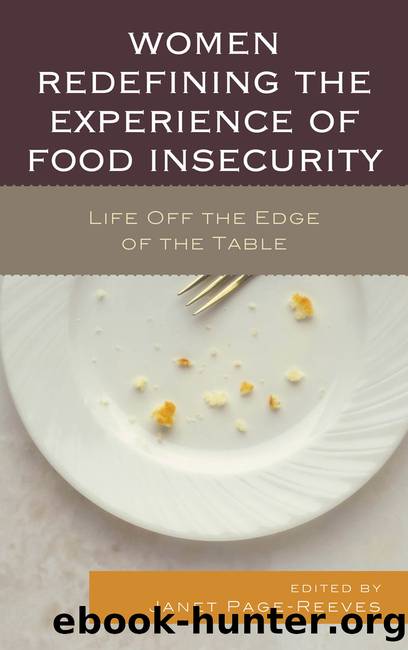Women Redefining the Experience of Food Insecurity by Page-Reeves Janet;

Author:Page-Reeves, Janet;
Language: eng
Format: epub
ISBN: 1732040
Publisher: Lexington Books
For each type of food Jessica sought (fruit, vegetables, meat, canned goods), she had a different source that met her dietary, taste, or economic needs. Although she walked for most of her food acquisition, the distance to Mustazaâs required her to go with her mother, who owns a vehicle. By combining sources and strategies, Jessica felt generally satisfied with her ability to get the foods she wanted.
Food banks were used by others as a strategy to mitigate cost. Wanda, a near-northwest resident in her 50s, stated that she hadnât bought canned goods in about three years because she could get them from food banks. She felt this strategy enabled her to afford fresh produce, dairy, and meat. Many other residents in the near-northwest took advantage of food bank sources. Numerous churches and food banks serving the poor stood out as one of the near-northwestâs only features that enabled food acquisition better than the lower-east. Chantel, a near-northwest resident in her early thirties, discussed the available nearby food bank sources: âChurches and stuff give out free food.... You just gotta know which ones to go to.â Many residents in near-northwest, like Chantel and Wanda, knew of several food bank sources. In our informal conversation after Chantelâs interview, she and some friends shared information about weekly food bank sources in the neighborhood that covered nearly every day of the week.
Traveling outside of the neighborhood to procure food was not an equally viable strategy for residents of the two neighborhoods in this study. June, a 40-year-old resident of the lower-east, was able to get to Eastern Market by walking: âI walk through the apartments and take my little shortcut and I end up over there at the Eastern Market.... I get a better deal.â Although June did not have an automobile, she was still able to pursue a strategy wherein she could obtain cheaper and healthier foods by walking to an adjacent section of the city. This is because of the lower-east neighborhoodâs proximity to Eastern Market. Kiara refused to shop at the store nearest to her because of quality concerns. She walked farther to shop at another store. However, she was still unsatisfied with the high prices at her alternative choice. Unlike June in the lower-east, Kiaraâs extra walking could only reasonably get her to a store that she was still somewhat dissatisfied with.
Seventeen of the 25 women expressed that concerns about crime often prevent them from conducting their everyday routines. Residents who were concerned about crime were more reluctant to walk longer distances to stores they perceived as better than options closer to home. Concerns about crime limited the ability of respondents to shop at stores outside of their immediate communities. Michelle, an 18-year-old woman living in the near-northwest, told how she was robbed during the daytime while walking about one mile from her home: âItâs certain places I wonât go in the daytime.... Like, the General Market ... thatâs where I got robbed at. And it was in daylight, you know? Wasnât nobody helping me.
Download
This site does not store any files on its server. We only index and link to content provided by other sites. Please contact the content providers to delete copyright contents if any and email us, we'll remove relevant links or contents immediately.
Craft Beer for the Homebrewer by Michael Agnew(18142)
Marijuana Grower's Handbook by Ed Rosenthal(3623)
Barkskins by Annie Proulx(3313)
Project Animal Farm: An Accidental Journey into the Secret World of Farming and the Truth About Our Food by Sonia Faruqi(3178)
The Plant Messiah by Carlos Magdalena(2883)
Red Famine: Stalin's War on Ukraine by Anne Applebaum(2873)
0041152001443424520 .pdf by Unknown(2784)
Organic Mushroom Farming and Mycoremediation by Tradd Cotter(2628)
In the Woods by Tana French(2533)
Beer is proof God loves us by Charles W. Bamforth(2372)
7-14 Days by Noah Waters(2361)
Reservoir 13 by Jon McGregor(2242)
Borders by unknow(2231)
Meathooked by Marta Zaraska(2220)
The Art of Making Gelato by Morgan Morano(2216)
Birds, Beasts and Relatives by Gerald Durrell(2178)
Between Two Fires by Christopher Buehlman(2164)
The 7 Habits of Highly Effective People: Powerful Lessons in Personal Change (25th Anniversary Edition) by Covey Stephen R(2139)
The Lean Farm Guide to Growing Vegetables: More In-Depth Lean Techniques for Efficient Organic Production by Ben Hartman(2096)
